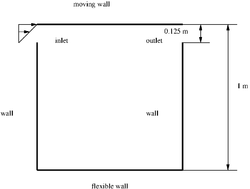Difference between revisions of "Lid driven cavity with a flexible bottom surface Michael Alletto"
(→Setup) |
(→Setup) |
||
| Line 53: | Line 53: | ||
The pressure was set to a zero gradient condition at the inlet. Regarding to the outlet the velocity was set to zero gradient and the pressure to a constant value of 0. The reason for the gap between the top wall and the side walls is to allow to set the pressure to zero at the outlet. This allows to fix the pressure value and allow a defined membrane movement. The membrane movement is dependent form the value of the pressure while the results in an incompressible fluid are only dependent from the gradient of the pressure. The Young modulus of the membrane located at the bottom wall was set to E = 250 N/m<sup>2</sup>, the density was set to &rho = 500 kg/m<sup>3</sup>$ and the Poisson ratio was set to &nu = 0. | The pressure was set to a zero gradient condition at the inlet. Regarding to the outlet the velocity was set to zero gradient and the pressure to a constant value of 0. The reason for the gap between the top wall and the side walls is to allow to set the pressure to zero at the outlet. This allows to fix the pressure value and allow a defined membrane movement. The membrane movement is dependent form the value of the pressure while the results in an incompressible fluid are only dependent from the gradient of the pressure. The Young modulus of the membrane located at the bottom wall was set to E = 250 N/m<sup>2</sup>, the density was set to &rho = 500 kg/m<sup>3</sup>$ and the Poisson ratio was set to &nu = 0. | ||
| + | |||
| + | |||
| + | [[File:lid_driven_cavity_flexible_bottom_alletto_cylinder_sketch.png|250px|center|sketch of the configuration]] | ||
==References== | ==References== | ||
Revision as of 13:25, 18 October 2023
- contributor: Michael Alletto
- affiliation: WRD MS
- contact: click here for email address
- OpenFOAM versions: v2112
- Published under: CC BY-NC-ND license (creative commons licenses)
Go back to Collection by authors.
You can download the case https://gitlab.com/mAlletto/openfoamtutorials/-/tree/master/membranBCSend/testCases/nonLinMembraneStaightDisplacement/lidDrivenCavity] here.
Introduction
In this small tutorial we will see how to simulate a fluid structure interaction problem with the membrane boundary conditon shown in the tutorial https://wiki.openfoam.com/Coupling_a_simple_nonlinear_membrane_to_point_displacement_Michael_Alletto. The test case consists in the well kown lid driven flow. In order to allow for fluid structure interaction (FSI) the bottom wall is flexible. The same test case was already used in order to validate a number of FSI codes (see e.g. [1]-[3]).
Setup
The setup of the simulation is shown in the following figure. It consists in a lid driven cavity case with some modifications. The difference to the classical case are the following: The bottom wall is flexible and is allowed to deform. The top wall is moving with a time varying velocity:
U = 1 - cos (2 pi t / 5).
The above boundary condition was implemented by using an expFixedValue boundary condition:
movingWall
{
type exprFixedValue;
valueExpr
#{
vector (1,0,0) - vector(1,0,0)*cos(2*3.1416*time()/5)
#};
}
The main purpose of having a time varying velocity is to have a time varying pressure. This leads to a time varying deformation of the bottom membrane. The last modification compared to the classical lid driven cavity is that there is gap between the top and the side walls of a height of 0.125 m. The length of the four sides of the square is 1 m. The viscosity of the fluid is set to &nuf = 0.01 m2/s2. The velocity at the inlet was varied linearly between 0 at the lower part of the gap and a value of the time varying velocity at the top of the gap. This boundary condition was also achieved by using an exprFixedValue boundary condition: inlet
{
type exprFixedValue;
valueExpr
#{
(vector (1,0,0) - vector(1,0,0)*cos(2*3.1416*time()/5)) *
(pos().y() - 0.875) / (1.0 - 0.875)
#};
}
The pressure was set to a zero gradient condition at the inlet. Regarding to the outlet the velocity was set to zero gradient and the pressure to a constant value of 0. The reason for the gap between the top wall and the side walls is to allow to set the pressure to zero at the outlet. This allows to fix the pressure value and allow a defined membrane movement. The membrane movement is dependent form the value of the pressure while the results in an incompressible fluid are only dependent from the gradient of the pressure. The Young modulus of the membrane located at the bottom wall was set to E = 250 N/m2, the density was set to &rho = 500 kg/m3$ and the Poisson ratio was set to &nu = 0.
References
[1] Jean-Frédéric Gerbeau and Marina Vidrascu. A quasi-newton algorithm based on a reduced model for fluid-structure interaction problems in blood flows. ESAIM: Mathematical Modelling and Numerical Analysis, 37(4):631–647, 2003.
[2] Christophe Kassiotis, Adnan Ibrahimbegovic, Rainer Niekamp, and Her- mann G Matthies. Nonlinear fluid–structure interaction problem. part i: implicit partitioned algorithm, nonlinear stability proof and validation examples. Computational Mechanics, 47:305–323, 2011.
[3] Jesús Gerardo Valdés Vázquez. Nonlinear analysis of orthotropic mem- brane and shell structures including fluid-structure interaction. 2007.
